Soft crunches…a steady cadence…upwind… Msko-waagosh paused. A foreleg stepped with no sound, a crackle, then the left foreleg stepped. An ear twitched. The doe’s head disappeared behind a thick oak tree. The returned white captive, taught the ways of the forest his adopted Ojibwe father, dropped to his right knee, taking the form of a bush, more than that of a man.
The doe, mature and healthy, angled down the steep slope, well beyond the distance of Msko-waagosh’s Northwest gun. She paused at the tangle of raspberry switches, testing the air with her nose while she surveyed the hillside. Twenty-five paces upwind of where she lingered, three hefty red cedar trees leaned against a fourth. The shallow roots of those trees gave way one gusty night after a March ice storm. Other cedars in that area lost tops or forked limbs.
With a flick of her tail, the doe began walking again. She stopped under the last cedar that grew at the edge of the big swamp. Again she looked about and sniffed. With one last glance to the south, into the wind, she started splashing along the trail that passed through the sedge grass. Brown eyes, those of an experienced forest tenant, watched and waited.
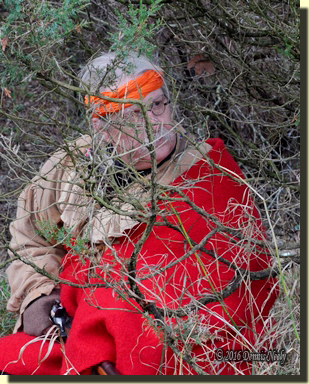
Mid-morning on that overcast November day in the Year of our Lord, 1794, Msko-waagosh grew restless. His quest for fresh venison began at first light. Buffalo-hide moccasins hustled up the rise and crossed the clearing. At the hardwoods, he paused, then started stalking on the trail that led east over the thin mound of earth that separated the nasty thicket from the huckleberry swamp. He spent the day’s first hours tucked in a rotting oak top that crashed down many years before. He thought perhaps the downed cedar mess on the east side of the ridge might prove a better location.
A dozen minutes passed. Msko-waagosh stood, stretched and continued his still-hunt to the windfall, satisfied the doe was the sole traveler at that moment. His left moccasin cleared away leaves. He eased the bedroll into the corner of “the rabbit form,” as he called it, sat cross-legged and checked the trade gun’s prime.
When he discovered the tented cedar trees, he spent time dragging cedar tops and limbs to the south of the opening, stacking them to form a lair that hid his deathly shape. That season, the tops retained their browning foliage. With the passage of seasons, the improvement changed to an entanglement of grey, dead branches, yet it still offered considerable protection from wary eyes. Comfortable and content, Msko-waagosh waited until early afternoon…
Fallen Timbers…
The opening paragraphs of what was to be last Friday’s blog post waited on the computer screen. I went to the basement on a fact checking mission. While down there, Tami hollered. With my bad hearing, I didn’t make out what she said, but the tone was that of great distress. I ran upstairs, thinking something had happened to her. Rain pounded the house roof. The wind howled, and a quick, passing glance through the kitchen window saw a white sheet of horizontal rain with an occasional green, leafy limb flying by.
She told of seeing the steel-grey clouds, one group coming from the east and one from the west. She said she went out onto the back deck as the fronts collided, right over the house. Sheets of rain fell as she came inside. “Then the wind started,” she said with grave concern as she watched the torrent.
We live on the top of a hill, overlooking the village in the distance. We have a birds-eye view of all manner of weather, good or bad. We’ve had 80 mph winds before, but never pushing so much rain; three-and-a-half inches in a half hour, which is equivalent to over an inch of snow a minute from a Michigander’s perspective. A maple limb came down in our yard, and down the hill another blocked the road, and of course the power went off. We were fortunate.
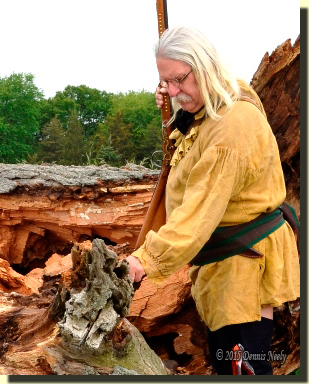
Once we checked the house and touched base with our neighbors—with masks and social distancing. Then my thoughts turned to the North-Forty, but with that much rain, I didn’t want to tear up the wagon trails with the tractor. I finally made it in yesterday.
Broken trees, all large, block the wagon trail in multiple locations, most leaning or tented and dangerous to an old sawyer. I shared photos with Tami, explaining what was down and where.
As we talked, I put dots on the property map. There are 70 trees of varying species broken, tipped or uprooted—and those are just the ones I could see from the tractor. The dots form two lines that suggest two tornado tails were aloft.
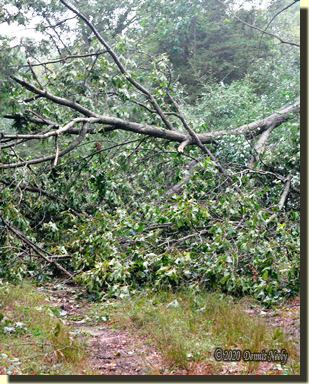
Some of the tipped or damaged trees will live, some will not. All will be difficult to clean up, taking months. “Sad” was the word I used to describe the scenes, but such destruction is the nature of change in the glade.
I emailed a fellow living historian, “We can re-enact Fallen Timbers,” tongue in cheek. That episode of American history is thirty years in the future as far as his persona goes. But as so often happens, a few days before we were talking about Fallen Timbers, speculating on fighting in debris left by a tornado. The Good Lord has an uncanny sense of humor, or so it seems.
August 20, 1794, General Anthony Wayne and the Legion of the United States attacked the Native American confederacy under Blue Jacket, Little Turtle and other tribal chiefs close to the Maumee River near what is now Maumee, Ohio. Wayne’s defeat of the confederacy led to the Treaty of Greenville signed in 1795. For this living historian, the timing of this storm is ironic.
In our discussion, I referenced Jonathan Alder, taken captive in May of 1782 at the age of 9 years. Of late, Alder’s writings have taken a back seat to John Tanner, the prime inspiration for Msko-waagosh, and James Smith, Mi-ki-naak’s mentor. But Alder’s narrative tells of the confederacy’s attack on Fort Recovery and also gives a first-hand account of the events of Fallen Timbers, seen through the eyes of white captive.
“…Of those that was surrounded,” Alder stated, “some broke for the fallen timber while some plunged into the river. What did not get shot swam across and made their escape, while others who stood their ground and fought were either killed or taken prisoner…” (Alder, 115).
Careful North-Forty Considerations…
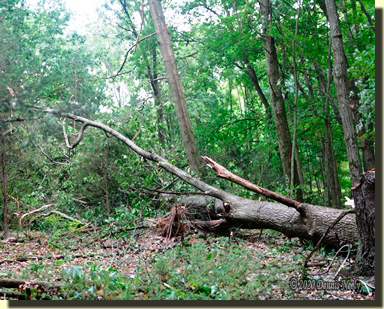
After the disappointment and mourning passes—one of the red oaks that came down was the “Yellow Tree”—the normal reaction is to start cutting and hauling brush; get the job done! But this is a time to step back and consider the circumstances. There are a number of perspectives that must be pondered.
Clearing the access roads is the first priority of the modern property manager. Diseases or bugs entering the tree wounds are a concern, and mitigating that potential for additional damage is important. Habitat management issues arise, too, as some debris is best left alone. While some landowners consider rotting tree tops unsightly, they represent spacious condominiums for the forest’s smaller tenants. The question is, “Are those tenants desirable, or undesirable?”
Land managed for abundant wildlife comes with its own set of considerations. In the past, the removal of the autumn olive, an invasive species, resulted in burn piles as a method of dealing with the uprooted bushes. Then two years ago, I began piling the skeletons to create “rabbitat” to offer shelter for cottontail rabbits. The rabbit population is increasing, despite red-tailed hawks, foxes and coyotes.
And then there is the living history perspective. Ice, snow and a fallen limb destroyed Msko-waagosh’s wigwam. A couple of years before that, an oak limb crushed the post hunter’s brush shelter, the one fashioned after Meshach Browning’s description. Mi-ki-naak’s peaked wigwam is not completed, and a young wild cherry with rot issues tipped over in front of it.
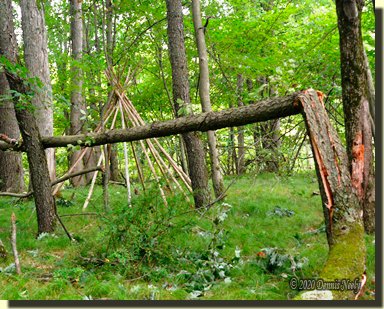
When I saw the foliage, my first impression was one of paranoia: “Why do trees keep falling on my camps?” I muttered. But when I drew close, the tree was well in front of the Mi-ki-naak’s future abode. Now the question is, “Do I clean up the cherry, or leave it as a reminder of the storm?”
A number of tornadoes ripped through southern Michigan, northern Indiana and Ohio on a balmy spring evening in 1965. My dad told of hearing “the rumbling of the freight train” as one passed to the south. We were young and in the basement.
There are several pieces of sheet metal that still remain where they fell on that Palm Sunday. These are remembrances of the past. Now and again, one of my alter egos deviates from his time period and says a prayer in honor of those who died in that storm. And likewise, our dining room table, fashioned in the Shaker style, was made from a red oak that was damaged, but survived “the Palm Sunday tornadoes,” as they are known locally.
Using natural cover is a hallmark of all three of my personas—no tree stands or “people boxes” for these old codgers—just the blessings of the forest, used to their best advantage. Each of the storm’s victims must stand on its own merits in a history-based sense, weighed against proper land management ethics.
In addition to wildlife habitat and historic building materials, these are the lairs for future pursuits, just as the three tipped cedar trees and the adjacent tops formed a wilderness niche that spawned outdoor tales over many years. It’s just frustrating that there are so many of them, but as the seasons pass, the blessings of the storm will be evident as the cherished moments add up…
Give traditional black powder hunting a try, be safe and may God bless you.



One Response to As Seasons Pass